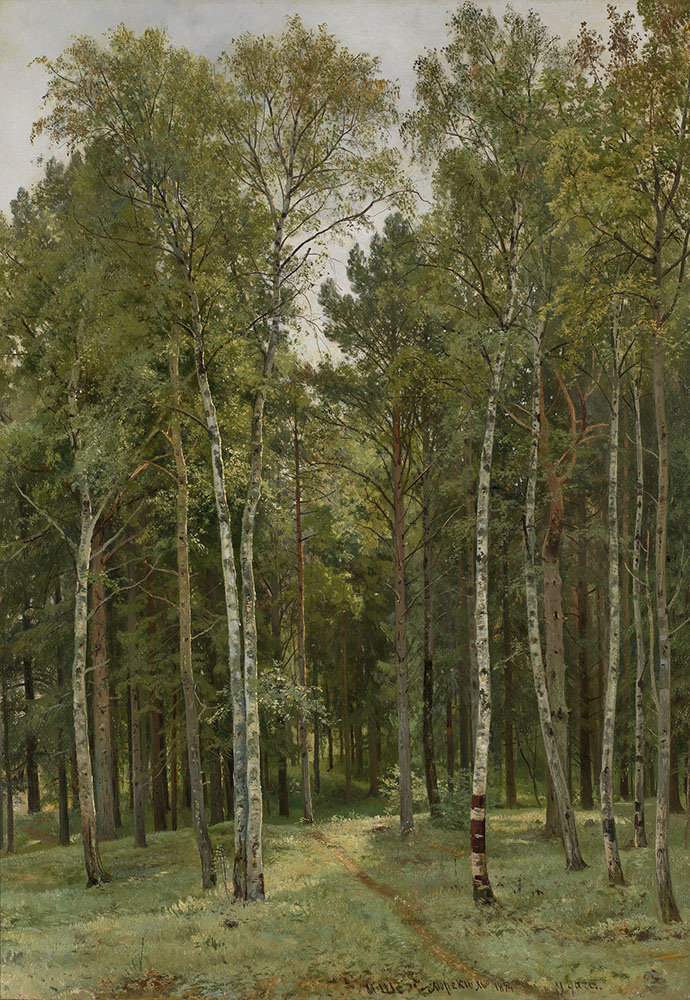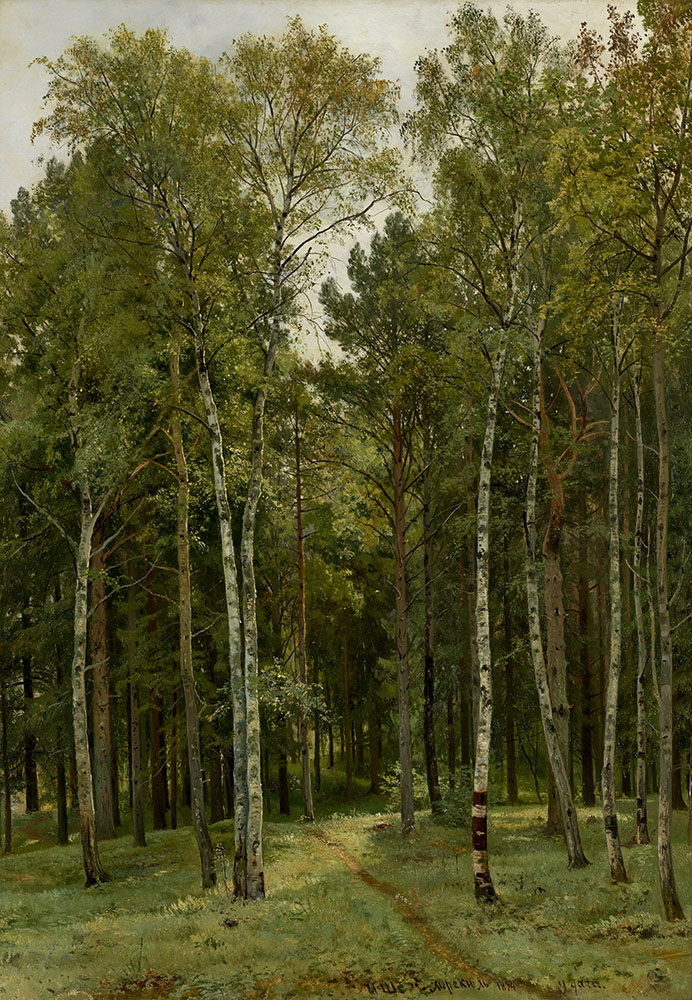MacDougall Auctions 12-18 June 2008
12 June 2008

21. SHISHKIN, IVAN 1832-1898
Meriküla - At the Dacha signed, dated 1984 and inscribed 'Merekul' in Cyrillic.
Oil on canvas, 105.5 by 74 cm.
750,000-1,500,000
Authenticity certificate from Vladimir Petrov.
The picture shows a view of a park in the spa town of Meriküla (in Estland Province, on the shores of the Gulf of Finland, 14 versts from Narva), where from 1893 to 1894 Shishkin worked at his rented dacha. Many sketches, studies and finished pictures from this period survive, each depicting various corners of the forest and park at Meriküla, notably the work At the Dacha (1894), which is held in Tatarstan State Museum in Kazan, in which the mixed deciduous and coniferous vegetation is similar to that depicted in By the Dacha which is presented here for auction as well as the work Sunny Day. Meriküla (1894, Pushkin Museum of Fine Arts Museum of Private Collections, Moscow), Pine Tree, Meriküla (1894, Vladimir Suzdal Museum Reserve), the study Forest by the Sea (1893, State Tretyakov Gallery) and others.
Our attention is drawn by the qualities of the composition, with its linear structure and the space in the centre, where the depth appears accentuated by the way the eye is drawn deep along the path, and the painterly solution, stippling, distribution of light and colour, accentuates the way the tree trunks and branches are painted, with occasional strokes here and there made with the brush handle. All these devices are characteristic of the famous portrait artist’s late period and have many analogies among his signature works.
The work is given a particular poetry by the masterly way in which the freshness of the greenery on the deciduous trees is conveyed, the luminescence of the sky almost tangibly conveying a feeling of a cool day, probably in spring, to the viewer. This ability to individualise the mood is a typical and commonly used landscape motif and one of the strongest aspects of Shishkin’s creative talent, which brought him deserved recognition in his lifetime and enduring fame to this day as one of the most poetic European landscape painters of the 19th century.
Grigory Goldovsky
<>BR/>
Meriküla – at the Dacha, one of the later works of Ivan Shishkin, was painted at the small resort of Meriküla on the Narva coast, where at the end of the 19th century large numbers of Russian artists used to spend the summer months. The dacha area on the banks of the Gulf of Finland, about 4½ miles from Korf station on the Baltic railway, had a gently sloping coastline and sandy beach, a pine forest and a wonderful park, and was a source of inspiration not only for Shishkin but also Vereshchagin, Nabokov, Pasternak and Leskov. Shishkin worked both here and in neighbouring Shmetsk throughout the summer of 1894, gathering his strength and impressions before going to head a studio at the newly reformed Imperial Academy of Arts in St Petersburg.
For the sixty year old Shishkin his stay in Meriküla proved extremely fruitful. It was here he produced his famous landscapes The Dense Forest (1894, Volsky Museum of Local Lore, History and Economy), A Sunny Day – Meriküla (1894, Pushkin State Museum of Fine Arts), and The Pine Tree – Meriküla (1894, Vladimir & Suzdal Museum of History, Art and Architecture). They were his response to the avant-garde trends in Russian figurative art that began in the early 1890’s. Shishkin, while striving to express the more complex and delicate states of nature which struck a chord in the human soul, was always true to himself, and never changed his painting style. His technique was founded upon disciplined drawing, clear forms, precise colouring of each detail and astoundingly fluid brush strokes.
It is from this period that the landscape Meriküla – At the Dacha, presented here for auction, originates. Based on sketches, it reproduces a corner of the famous leafy grove at Meriküla which often attracted Shishkin’s interest due to its rich range of colour tones and constantly changing light. He chose a vertical composition for this work and, in contrast with the masterpiece at the Kazan Museum On a Bench, by the Dacha (1894, Tartarstan State Museum of Figurative Arts, Kazan) where he portrayed the border of the grove drenched in sunshine, here he painted the path disappearing into the depths of the forest.
The painting was executed with light, fast brush strokes which had the strength and freshness of an immediate, direct gaze. This lively and changeable nature of the work and the technical methods of separate brushstrokes, mixing of oils to produce a calculated optical effect, and delicately highlighted colour tones brought it close to the works of the Impressionists. Shishkin also had the Impressionist understanding of the representation of nature by the harmonious use of form and colour.
The grass, trees and sky are wreathed in a haze, and were painted as a whole; they interact with one another and the light and air which surrounds them. The work employs an accomplished en plein air technique which renders the images convincing and full of life. The pure luminosity of colour permeating the painting creates the impression of sunshine sparkling on a Summer’s day and of a heightened emotional state, making this a superior example of a lyrical landscape, and one of the most affecting works of Shishkin’s Meriküla series.

Notes on symbols:
* Indicates 5% Import Duty Charge applies.
Ω Indicates 20% Import Duty Charge applies.
§ Indicates Artist's Resale Right applies.
† Indicates Standard VAT scheme applies, and the rate of 20% VAT will be charged on both hammer price and premium.